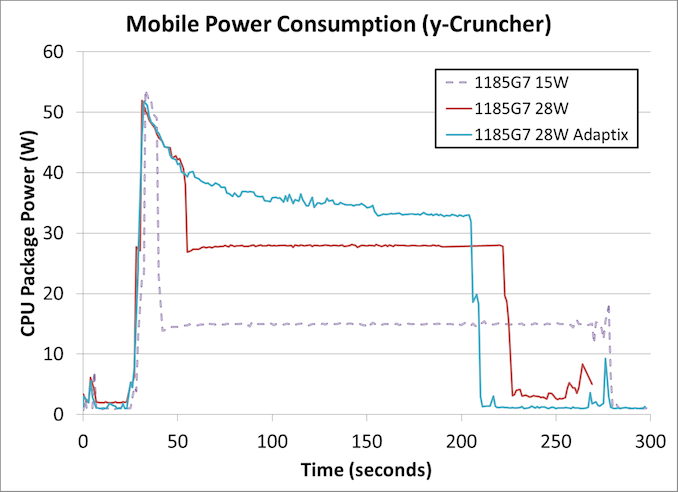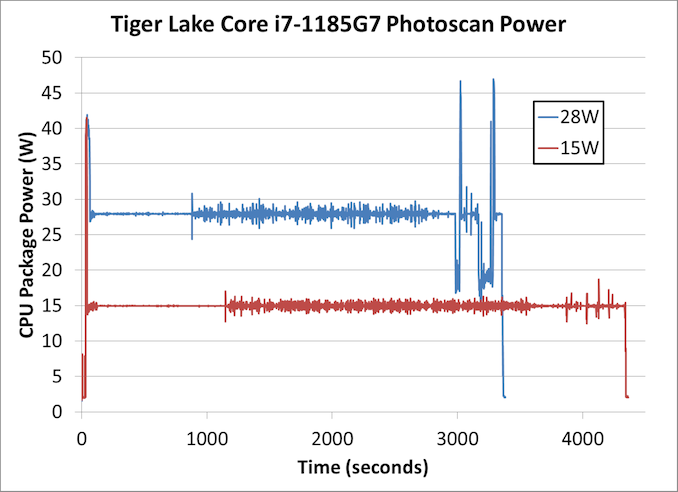Intel’s Tiger Lake 11th Gen Core i7-1185G7 Review and Deep Dive: Baskin’ for the Exotic
by Dr. Ian Cutress & Andrei Frumusanu on September 17, 2020 9:35 AM EST- Posted in
- CPUs
- Intel
- 10nm
- Tiger Lake
- Xe-LP
- Willow Cove
- SuperFin
- 11th Gen
- i7-1185G7
- Tiger King
Comparing Power Consumption: TGL to TGL
On the first page of this review, I covered that our Tiger Lake Reference Design offered three different power modes so that Intel’s customers could get an idea of performance they could expect to see if they built for the different sustained TDP options. The three modes offered to us were:
- 15 W TDP (Base 1.8 GHz), no Adaptix
- 28 W TDP (Base 3.0 GHz), no Adaptix
- 28 W TDP (Base 3.0 GHz), Adaptix Enabled
Intel’s Adaptix is a suite of technologies that includes Dynamic Tuning 2.0, which implements DVFS feedback loops on top of supposedly AI-trained algorithms to help the system deliver power to the parts of the processor that need it most, such as CPU, GPU, interconnect, or accelerators. In reality, what we mostly see is that it reduces frequency in line with memory access stalls, keeping utilization high but reducing power, prolonging turbo modes.
Compute Workload
When we put these three modes onto a workload with a mix of heavy AVX-512 compute and memory accesses, the following is observed.
Note that due to time constraints this is the only test we ran with Adaptix enabled.
This is a fixed workload to calculate 2.5 billion digits of Pi, which takes around 170-250 seconds, and uses both AVX-512 and 11.2 GB of DRAM to execute. We can already draw conclusions.
In all three power modes, the turbo mode power limit (PL2) is approximately the same at around 52 watts. As the system continues with turbo mode, the power consumed is decreased until the power budget is used up, and the 28 W mode has just over double the power budget of the 15 W mode.
Adaptix clearly works best like this, and although it initially follows the same downward trend as the regular 28 W mode, it levels out without hitting much of a ‘base’ frequency at all. Around about the 150 second mark (120 seconds into the test), there is a big enough drop followed by a flat-line which would probably indicate a thermally-derived sustained power mode, which occurs at 33 watts.
The overall time to complete this test was:
- Core i7-1185G7 at 15 W: 243 seconds
- Core i7-1185G7 at 28 W: 191 seconds
- Core i7-1185G7 at 28 W Adaptix: 174 seconds
In this case moving from 15 W to 28 W gives a 27% speed-up, while Adaptix is a total 40% speed-up.
However, this extra speed does come at the cost of total power consumed. With most processors, the peak efficiency point is when the system is at idle, and while these processors do have a good range of high efficiency, when the peak frequencies are requested then we are in a worst case scenario. Because this benchmark measures power over time, we can integrate to get total benchmark power consumed:
- Core i7-1185G7 at 15 W: 4082 joules
- Core i7-1185G7 at 28 W: 6158 joules
- Core i7-1185G7 at 28 W Adaptix: 6718 joules
This means that for the extra 27% performance, an extra 51% power is used. For Adaptix, that 40% extra performance means 65% more power. This is the trade off with the faster processors, and this is why battery management in mobile systems is so important - if a task is lower priority and can be run in the background, then that is the best way to do it to conserve battery power. This means things like email retrieval, or server synchronization, or thumbnail generation. However, because users demand the start menu to pop up IMMEDIATELY, then user-experience events are always put to the max and then the system goes quickly to idle.
Professional ISV Workload
In our second test, we put our power monitoring tools on Agisoft’s Photoscan. This test is somewhat of a compute test, split into four algorithms, however some sections are more scalable than others. Normally in this test we would see some sections rely on single threaded performance, while other sections use AVX2.
This is a longer test, and so the immediate turbo is less of a leading factor across the whole benchmark. For the first section the system seems content to sit at the respective TDPs, but the second section shows a more variable up and down as power budget is momentarily gained and then used up immediately.
Doing the same maths as before,
- At 15 W, the benchmark took 4311 seconds and consumed 64854 joules
- At 28 W, the benchmark took 3330 seconds and consumed 92508 joules
For a benchmark that takes about an hour, a +30% performance uplift is quite considerable, however it comes at the expense of +43% power. This is a better ratio than the first compute workload, but still showcases that 28 W is further away from Tiger Lake’s ideal efficiency point.
Note that the power-over-time graph we get for Agisoft on a mobile processor looks very different to that of a desktop processor, as a mobile processor core can go above the TDP budget with fewer threads.
This leads to the dichotomy of mobile use cases with respect to the marketing that goes on for these products - as part of the Tiger Lake launch, Intel was promoting its use for streaming, professional workflows such as Adobe, video editing and content creation, and AI acceleration. All of these are high-performance workloads, compared to web browsing or basic office work. Partly because Tiger Lake is built on the latest process technology, as well as offering Intel’s best performing CPU and GPU cores, the product is going to be pitched in the premium device market for the professionals and prosumers that can take advantage.












253 Comments
View All Comments
tipoo - Friday, September 18, 2020 - link
Sounds like their next Macbook releases are going to be Apple Silicon, not sure we'll ever see a TGL Apple system.AMDSuperFan - Thursday, September 17, 2020 - link
What worries me the most is that this Tiger is better than Renoir in every way possible. I feel like Intel is the Apple of laptops now and our AMD are some knockoff tablet with good specs but not up to snuff. This 4 core beating the 8 core Renoir is terrible. I know we have Big Navi coming and that should save us here, but right now the Nvidia and Intel products are really bad for us fans.Spunjji - Friday, September 18, 2020 - link
I worry about the mental health of the person running this account.eddman - Thursday, September 17, 2020 - link
Why intel didn't do 6-8 core low power models again? 10nm too power hungry? Low yields and/or low manufacturing capacity?Spunjji - Thursday, September 17, 2020 - link
Yes!But seriously, all of the above.
eek2121 - Thursday, September 17, 2020 - link
Fab capacity.RedOnlyFan - Friday, September 18, 2020 - link
Hahaha. Fake informationSpunjji - Friday, September 18, 2020 - link
What's your explanation then, Red? "They didn't want to"?They compete well with AMD at 15W but need 28W to get full performance from the design. Squeezing twice as many cores in would push them way, way off the bottom of their efficiency curve. They're running more complex cores than AMD and they require more power, no way around that.
If yields were good enough they'd have had 8-core Ice Lake designs out taking the fight back to AMD on the desktop, but mysteriously they skipped those and rehashed Skylake again. It's almost like something was holding them back...
JayNor - Thursday, September 17, 2020 - link
Intel chose to integrate high performance wifi6, thunderbolt 4, avx512, dlboost, pcie4 features rather than the more small hammers approach.Alder Lake will have even smaller and lower power cores than AMD's, so perhaps next year the choice for Cinebench processing will get funny.
RSAUser - Thursday, September 17, 2020 - link
You mentioned this again, so I'll comment again:WiFi 6/802.11ax: AMD does not do networking equipment, it's also not part of the CPU, it's an
extra module attached to the mobo.
PCIe 4: No benefit in laptops, there's no SSD that can really max it out consumer side and GPU wise. PCIe 4 consumes a lot more power than 3rd gen.
Thunderbolt 4: You actually mean USB 4.
AVX512: Not many things actually use this, a majority of those use-cases can just go GPU, and you're not really running an AVX512 workload on a laptop.
DLBoost: Intel's ML library, you're not training ML libraries on a laptop CPU, you'd near always want to use a GPU instead, plus that specific one is Intel's trademark one, you'd use open source alternatives.
AMDs' leaked roadmaps are USB 4 and PCIe 4 in 2022, and here you didn't mention LPDDR5, which is also included in that release.